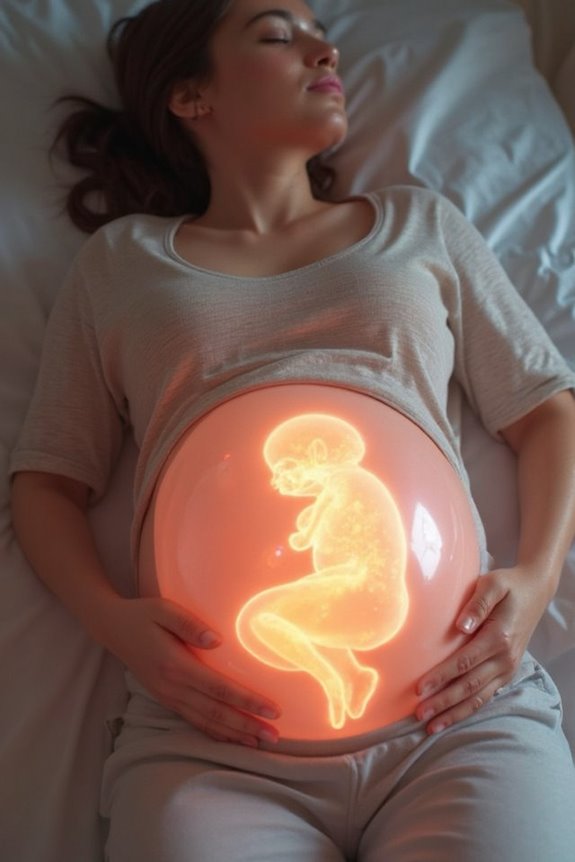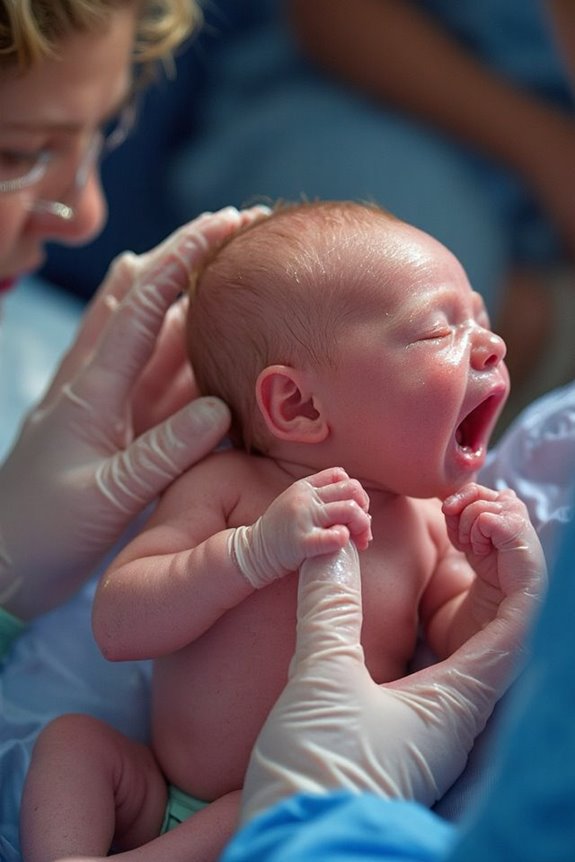Most babies naturally turn head down (cephalic position) between 28-32 weeks of pregnancy. By 32 weeks, about 90% of babies are head down, and nearly all reach this position by 36 weeks. You’ll likely notice changes when this happens: kicks felt higher in your abdomen, increased pelvic pressure, easier breathing, and a lower-appearing baby bump. If your baby hasn’t turned by 36 weeks, I’ll explain what options you might consider.
Key Takeaways
- By 32 weeks, approximately 90% of babies are in the head-down position.
- Before 28 weeks, about 75% of babies have already positioned themselves head down.
- Most babies complete the turn to head-down position by 36 weeks of pregnancy.
- By the third trimester, 97% of babies have moved into the optimal head-down position for birth.
- Early pregnancy babies change positions frequently, but gradually settle head-down as space becomes limited.
Normal Timing for Head-Down Position
Three key stages mark when babies typically turn head down during pregnancy. During early pregnancy stages, babies frequently change baby positioning due to ample space in the uterus. By 32 weeks, approximately 90% of babies have rotated to a head-down position, with most remaining babies turning by 36 weeks.
The progression typically follows this pattern:
- Before 28 weeks: About 75% of babies are head down
- 28-32 weeks: Most babies begin settling into the cephalic (head-down) presentation
- 32-36 weeks: The majority achieve stable head-down positioning
This vertex presentation is ideal for delivery, reducing birth complications. While timing varies between pregnancies, by the third trimester, 97% of babies naturally move into head-down position as space becomes limited and they prepare for birth.
Signs Your Baby Has Turned Head Down
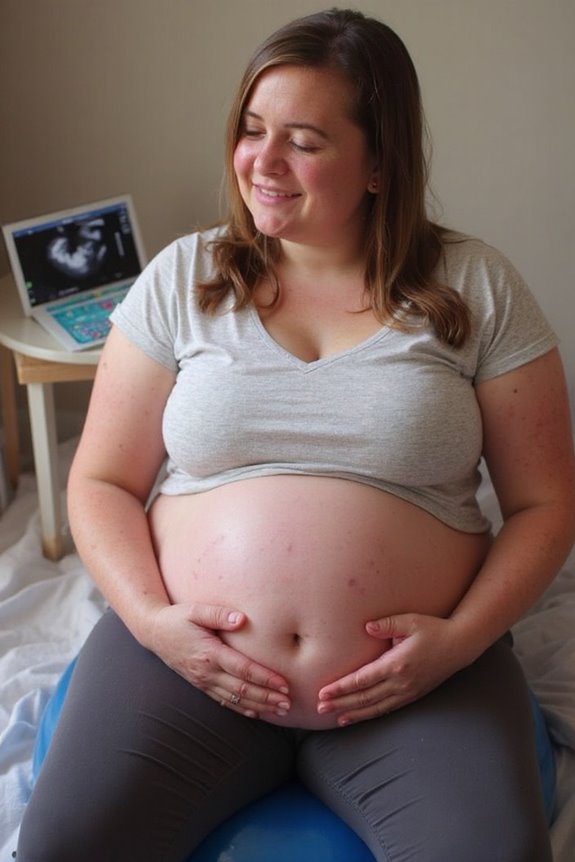
Recognizing the signs that your baby has turned head down can help you understand your body’s changes as you approach delivery. Many mothers notice distinct symptoms when this positioning occurs:
- Changes in fetal movements: You may feel kicks higher in your abdomen or under your ribs instead of your lower belly
- Increased pelvic pressure: More frequent urination and discomfort in your pelvic area are common as your baby’s head presses on your bladder
- Easier breathing: Less pressure on your diaphragm can make breathing less labored
- Physical changes: Your baby bump may appear lower or differently shaped
While these signs can be telling, only a healthcare provider can confirm your baby’s position through Leopold’s maneuvers or an ultrasound examination during your prenatal checkups.
Understanding Cephalic Presentation
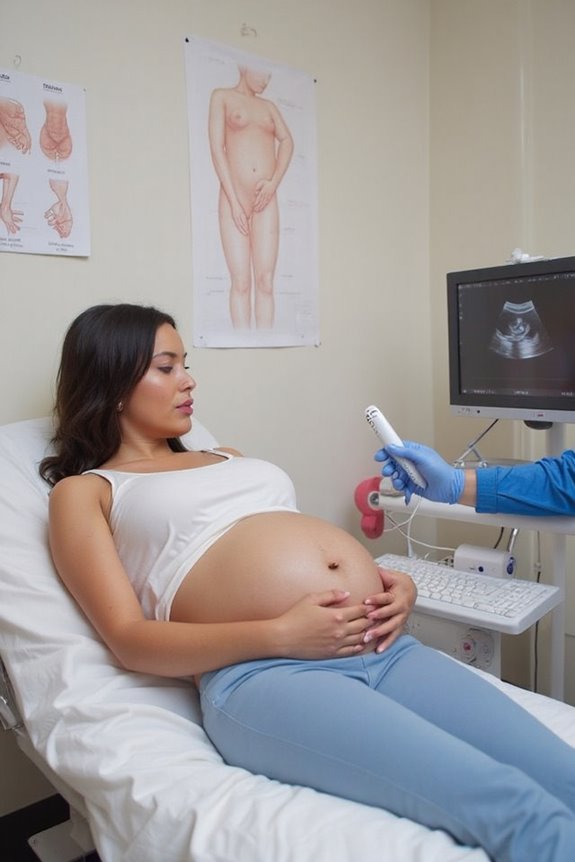
When your baby positions itself head-down in your uterus, it’s called cephalic presentation – the most common and typically ideal position for childbirth. This fetal positioning usually occurs around 32 weeks of pregnancy.
There are two main variations:
- Occiput Anterior Position: Baby is head-down with face toward your back. This is optimal, allowing the smallest part of the head to lead through the birth canal.
- Occiput Posterior Position: Baby is head-down but facing your abdomen. This “sunny-side up” position can lead to longer labor and may require intervention.
Proper cephalic presentation greatly enhances birth outcomes. Healthcare providers monitor your baby’s position throughout the third trimester to guarantee the best delivery approach, as this positioning impacts both labor duration and delivery method.
Why Some Babies Turn Earlier Than Others
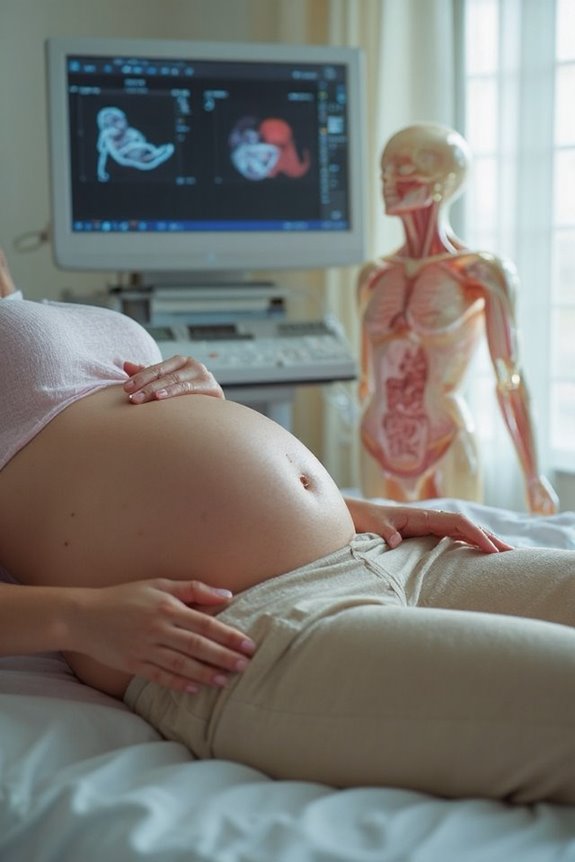
The timing of a baby’s head-down turn varies considerably between pregnancies due to numerous physiological and environmental factors. I’ve found that maternal anatomy plays a significant role, with uterine shape and pelvic structure directly affecting when a baby can comfortably settle head-down.
Your lifestyle choices matter too. Regular maternal activity encourages ideal fetal movement and positioning, while maintaining good posture maximizes uterine space. Women who’ve had previous pregnancies often experience earlier turning due to more elastic uterine muscles.
Fetal factors include:
- Baby’s size and weight (larger babies may turn earlier due to gravity)
- Development of coordination skills
- Individual movement patterns
Placenta position can also influence timing—a low-lying placenta may delay the baby’s ability to descend into the pelvis and assume the head-down position.
Medical Concerns if Baby Doesn’t Turn

Although most babies naturally assume a head-down position by 36 weeks, some remain in a breech presentation, which can lead to significant medical concerns.
When a baby stays breech, I’ll need to take into account several important factors:
- Breech complications: A breech position increases risks during vaginal delivery for both me and my baby, potentially leading to a longer labor or injury to the baby.
- Delivery options: My doctor will likely recommend a C-section, as it’s generally safer than attempting a vaginal breech delivery.
If my baby doesn’t turn by 36 weeks, my healthcare provider will monitor us more closely. Labor that begins with a breech baby can become a medical emergency, requiring immediate attention, especially for those with risk factors like carrying multiples or delivering prematurely.
Methods to Encourage Head-Down Positioning
Several proven methods can help encourage my baby to move into the ideal head-down position before delivery. I can try simple exercises like pelvic tilts, which involve gently rocking my pelvis back and forth while on all fours or standing.
Another effective technique is the breech tilt, where I lie on a flat surface with my feet elevated 9-12 inches above my head for about 10-15 minutes, allowing gravity to help shift my baby’s position.
Other helpful approaches include:
- Cat-cow yoga poses to create more space in the pelvis
- Regular walking to encourage natural movement
- Side-sleeping with a pillow between knees
- Chiropractic care (with practitioner experienced in prenatal care)
These methods work best when started early in the third trimester, before 36 weeks.
How Healthcare Providers Confirm Baby’s Position
Healthcare providers use several reliable techniques to confirm my baby’s position during pregnancy. During prenatal assessments, my doctor typically employs:
- Leopold’s Maneuvers: By carefully palpating my abdomen, they can identify the baby’s head, back, and buttocks.
- Ultrasound Technology: Provides visual confirmation of my baby’s exact position.
- Heartbeat Location: If detected near my pelvis, it suggests a head-down position.
These confirmation methods help distinguish between a breech (buttocks-first) and cephalic (head-down) presentation. My provider feels for firmness—a hard, round part indicates the head, while softer areas suggest the buttocks.
Additionally, electronic fetal monitoring may track my baby’s position indirectly. Throughout pregnancy, my healthcare provider monitors positional changes to help determine the safest delivery approach.
The Role of Baby’s Position in Labor and Delivery
My baby’s position during labor plays an essential role in determining how smoothly my delivery will progress. Fetal positioning directly impacts labor progression in several important ways:
- The best position—Cephalic Occiput Anterior (COA)—facilitates easier delivery as the smallest part of the baby’s head leads through the birth canal.
- Less favorable positions like Cephalic Occiput Posterior (COP) can cause longer labor and back pain.
My body position matters too:
- Upright positions (squatting, birthing chair) can widen the birth canal
- These positions use gravity to help baby descend
If my baby isn’t in an advantageous position, healthcare providers might:
- Recommend specific exercises before labor
- Perform manual rotation during delivery
- Consider interventions like forceps or C-section if necessary
Frequently Asked Questions
Can Twins or Multiples Both Turn Head Down?
Yes, I’ll explain twin positioning during pregnancy. In multiple births, it’s possible for twins to both turn head down independently. This positioning gives you a better chance for vaginal delivery, though it doesn’t always happen.
Does Maternal Weight Affect When Babies Turn Head Down?
I’ve found limited data on this topic. While maternal weight isn’t directly linked to fetal position timing, your maternal posture may have more influence on when your baby moves head-down than your weight alone.
Can Exercise Influence When a Baby Turns Head Down?
I believe gentle exercise can potentially help your baby turn. Exercise benefits include improved positioning through activities like prenatal yoga, spending time on all fours, or swimming – though results aren’t guaranteed for everyone.
Will Previous Pregnancies Affect When Babies Turn Head Down?
Yes, if you’ve had previous pregnancies, it may affect baby positioning. Your uterus might be more stretched, allowing greater mobility. This can sometimes delay when your baby settles into the head-down position.
Does Amniotic Fluid Volume Impact Baby’s Ability to Turn?
Like a swimmer needing water to move freely, I can tell you that amniotic fluid volume directly impacts your baby’s ability to turn. Adequate fluid provides the space necessary for changing fetal position.

